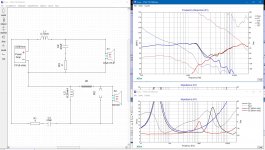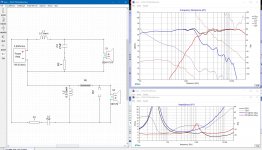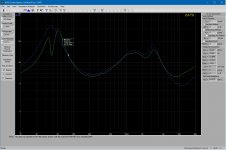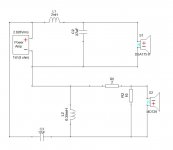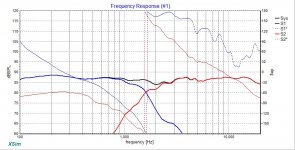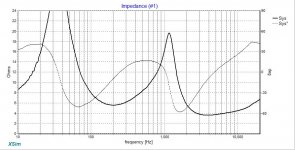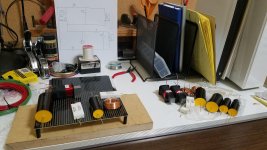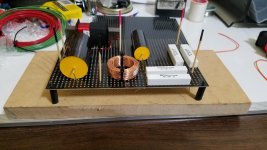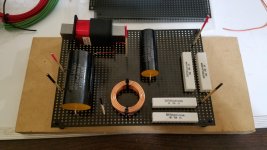Since this is for vocals, you will want proper weighting in the 200-600Hz range, actually everywhere, but this range can be compromised if you dont consider the baffle step. Fixing it is not perfect but it is much preferred.
I have learned so much the last couple of weeks and I want to touch back on one of my original goals in working with these Polk T50 speaker systems. These can be bought all day long not only new for cheap but also you can find these with blown tweeters because well sorry Polk but these are some really weak *** cheesy tweeters. Best Buy often has these brand new on sale for 99$. Heck you can buy them new mod them and sell the original drivers on ebay to get a little coin back. You can not build a box and buy passive radiators at that price level. So I want to share with you all my reverse engineer of the OEM Xovr in the following attachments. With only 2 Xovr components changed you could be darn close excepting for power handling of the modified Xovr. I only have gotten to this point with Allen's help in guiding me on a handbuilt Xovr so credit given there. The Morel MDT29 and Dayton DSA175-8 takes these boxes to a completely new level. I think if you did not intend to push power too much the modified original Xovr this path could be decent. With a proper built one and even the generic ones Im using these are LOUD and CLEAN. I like these as a project suggestion for those that do not have lots of tools nor wanting to build a box from scratch. A lot of research and thought has gone into this so far and Im getting there. I believe these fill a position with regards to size, and ease of mod that makes the project attractive. Flame away tell me your thoughts, I do know this though regardless of the extra cost of the MDT29 I am in Love with these tweeters, these will take more than my AVR has and that is WAY beyond the levels of listening DBs that are healthy anyway.
ps: I glued a quarter into each of the original passive radiators because it helps it fits and because I am a Rebel lmao........
ps: I glued a quarter into each of the original passive radiators because it helps it fits and because I am a Rebel lmao........
Attachments
Im going to order some parts. And then when I get one installed I can get some measurements. I need to measure each driver separately while connected to the crossover, is that correct? I have box dimensions for both enclosure styles. What is the best program to use for that? I do not see any box modeling in Xsim. I see there is something in PCD but I need to learn how to use it. I also started messing around in Vituix Cad but yea Im not good at that.
You shouldn't need to do any box modelling.. If you have the box and the drivers selected, when you measure you'll be measuring everything. That includes the box volume, and the outside effects.
Measure all the woofers at once without a crossover.
Measure all the woofers at once without a crossover.
This is a most interesting project, I'm enjoying following it.
I suspect that the main thing which puts people off DIY is having to build the cabinets, and making them look good (WAF). To get nice looking cabinets for $99 is brilliant, as long as the construction quality is workable. Getting the MDF cut to size here would be around $200!
Of course, the cabinet has limited your selection of drivers but in some ways that might have made the project a bit easier: e.g. narrowing down your woofer options from 20 to two or three.
You've been able to learn heaps and people have been happy to help you through the process to make your own, good-sounding speakers.
Those Polks are $750 here in Melbourne, which would make this project un-viable, unfortunately but used they might be reasonable.
I hope it all turns out well for you
Geoff
I suspect that the main thing which puts people off DIY is having to build the cabinets, and making them look good (WAF). To get nice looking cabinets for $99 is brilliant, as long as the construction quality is workable. Getting the MDF cut to size here would be around $200!
Of course, the cabinet has limited your selection of drivers but in some ways that might have made the project a bit easier: e.g. narrowing down your woofer options from 20 to two or three.
You've been able to learn heaps and people have been happy to help you through the process to make your own, good-sounding speakers.
Those Polks are $750 here in Melbourne, which would make this project un-viable, unfortunately but used they might be reasonable.
I hope it all turns out well for you
Geoff
Thank You Geoff
Thank you for the input and your help on this. You were one of the first to step up and help. 750 OMG why are these so expensive there? I always wanted to learn more about crossovers and this project has forced me past the intimidation and into a fun journey. Looking forward to the crossover to come and measuring and listening.
Thank you for the input and your help on this. You were one of the first to step up and help. 750 OMG why are these so expensive there? I always wanted to learn more about crossovers and this project has forced me past the intimidation and into a fun journey. Looking forward to the crossover to come and measuring and listening.
Measurments?
Should I be measuring both with the DATs no power, and then also with microphone and pink or white noise under power with no crossover?
You shouldn't need to do any box modelling.. If you have the box and the drivers selected, when you measure you'll be measuring everything. That includes the box volume, and the outside effects.
Measure all the woofers at once without a crossover.
Should I be measuring both with the DATs no power, and then also with microphone and pink or white noise under power with no crossover?
Hmm, I don't use DATs. It is better to use swept sine than pink noise. It is not necessary to push them hard unless you are testing their limits.
Ok got some measurements done on this existing modified Xovr. Im using the DATs V3. I simply love this tool. I have been able to reverse engineer circuits. I have been able to confirm good or dead vintage capacitors, measure inductors caps resistors. I love this device and it is so well made. Just very professional especially at the price point it is sold for. Kudos to Dayton and Parts Express. Just to reiterate this is not the crossover I intend to build this is the Dayton 2.5K that is modified some. But the Box measurements on the woofer are good to go or use.
Attachments
-
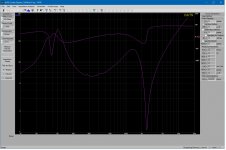 Woofer with Xovr Tweeter disconnected Box Fully Loaded.jpg236.6 KB · Views: 77
Woofer with Xovr Tweeter disconnected Box Fully Loaded.jpg236.6 KB · Views: 77 -
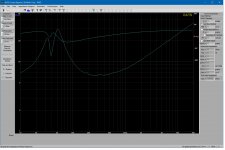 Woofer No Xovr In Box Fully Loaded.jpg232 KB · Views: 76
Woofer No Xovr In Box Fully Loaded.jpg232 KB · Views: 76 -
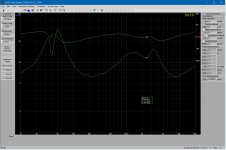 Both Drivers W Xovr Box Fully Loaded.jpg236.5 KB · Views: 76
Both Drivers W Xovr Box Fully Loaded.jpg236.5 KB · Views: 76 -
BLF62 Cntr woofer w xovr dayton 2.5k mod v1 081521.zma.txt11.4 KB · Views: 46
-
BLF62 Cntr woofer NO xovr dayton 2.5k mod v1 081521.zma.txt11.4 KB · Views: 47
-
BLF62 Cntr both drvs dayton 2.5k mod v1 081521.zma.txt11.4 KB · Views: 44
Last edited:
Always Learning
Ok this completely impressed me. I measured with the DATs V3. Then I loaded the exported data from Xsim where I measured the existing Xovr and put in the derived driver data. This really bolsters confidence in this tool. What you think Allen B?
Ok this completely impressed me. I measured with the DATs V3. Then I loaded the exported data from Xsim where I measured the existing Xovr and put in the derived driver data. This really bolsters confidence in this tool. What you think Allen B?
Attachments
Simulators are surprisingly accurate at audio frequencies. Your biggest inconsistencies will probably happen in the sound measurements.
Allen I have a few questions.
1. What watt rating should I be getting for these resistors?
2. I see you have both drivers inverted and I also can see that changing those greatly changes the phase lines. Do these filters alter phase at each level, and this is necessary? I seem to remember that is the case with many of the tube circuits I was messing with in the past. That is each leg of filter changed phase 180 degrees, is that correct?
3. Your suggestion puts the transfer region much lower than I was shooting for. Can you explain that some, maybe I am still not understanding the transfer region? I thought for this tweeter 1800 was about as low as I could safely go.
1. What watt rating should I be getting for these resistors?
2. I see you have both drivers inverted and I also can see that changing those greatly changes the phase lines. Do these filters alter phase at each level, and this is necessary? I seem to remember that is the case with many of the tube circuits I was messing with in the past. That is each leg of filter changed phase 180 degrees, is that correct?
3. Your suggestion puts the transfer region much lower than I was shooting for. Can you explain that some, maybe I am still not understanding the transfer region? I thought for this tweeter 1800 was about as low as I could safely go.
Last edited:
1. Xsim will show you maximum power per frequency. It will help you guess which resistors need to be larger.
2. I invert both drivers only so it is easier to see phase on the plot. You don't really need to invert them.
3. I don't know these drivers and I'm not trying to give you a good crossover.. that would take a long time. I'm just showing you small techniques on the simulator.
2. I invert both drivers only so it is easier to see phase on the plot. You don't really need to invert them.
3. I don't know these drivers and I'm not trying to give you a good crossover.. that would take a long time. I'm just showing you small techniques on the simulator.
Ok Thank you
Cool I did not know that was in Xsim I'll look closer.
Well you made a very flat crossover better than my guesses and your phase lines looked way better. I see that these 2 drivers are not the most perfect match. I chose these based on reasons that included fitting in these boxes. I will most likely use the Morel tweeter more in the future as I love the detail even with a just ok Xovr. I changed what you shared and moved the crossover point up some. When considering the crossover point is it ok or is there room to wiggle with regards to the tweeter crossover point? Another words since we are cutting fairly steep is it ok to fudge some. say if the ideal textbook freg says go no lower than 1.8k, the Xovr true cross is 1.5k, but the tweeter is down significantly or beginning to drop at say 2k. I know that is a very general question but in theory I mean not just for these drivers.
I think what I am about to put together will be better than what I am using and if the current topology is improved and moving in the right direction I should get some joy from these. Thanks again I hope I am not bugging you with so many questions but this is exciting to be doing and learning.
Cool I did not know that was in Xsim I'll look closer.
Well you made a very flat crossover better than my guesses and your phase lines looked way better. I see that these 2 drivers are not the most perfect match. I chose these based on reasons that included fitting in these boxes. I will most likely use the Morel tweeter more in the future as I love the detail even with a just ok Xovr. I changed what you shared and moved the crossover point up some. When considering the crossover point is it ok or is there room to wiggle with regards to the tweeter crossover point? Another words since we are cutting fairly steep is it ok to fudge some. say if the ideal textbook freg says go no lower than 1.8k, the Xovr true cross is 1.5k, but the tweeter is down significantly or beginning to drop at say 2k. I know that is a very general question but in theory I mean not just for these drivers.
I think what I am about to put together will be better than what I am using and if the current topology is improved and moving in the right direction I should get some joy from these. Thanks again I hope I am not bugging you with so many questions but this is exciting to be doing and learning.
You can usually take a tweeter lower. Sometimes it is no problem and sounds good. Sometimes you can't turn it up much before it distorts, and it will be easier to damage.
As Built
So this is what I decided on and I may have to add more series resistor to the tweeter. Really just lightly higher Xovr point than yours. The resistors I chose may need a higher rating.
So this is what I decided on and I may have to add more series resistor to the tweeter. Really just lightly higher Xovr point than yours. The resistors I chose may need a higher rating.
Attachments
You can look at your woofer. Where does it go narrow and breakup. This is the first thing to help you decide where to cross.
Component Layout & Xovr Board Stand
My parts came in today. I am so glad I purchased the DATs V3. I was able to verify the values of each part. I was also able to put the best matches together with 3 full sets I matched for the FL & FR and put the components that were a smidge different to the center crossover. I know the numbers are insignificant but Im a detail freak. I built a Xovr board stand with a single piece of MDF 4 nails & vacuum tube spacers. This allowed me to work on the component layout without mangling up the leads. The following pics are what I'm doing and it is time to break out the soldering iron and get these puppies put together.
My parts came in today. I am so glad I purchased the DATs V3. I was able to verify the values of each part. I was also able to put the best matches together with 3 full sets I matched for the FL & FR and put the components that were a smidge different to the center crossover. I know the numbers are insignificant but Im a detail freak. I built a Xovr board stand with a single piece of MDF 4 nails & vacuum tube spacers. This allowed me to work on the component layout without mangling up the leads. The following pics are what I'm doing and it is time to break out the soldering iron and get these puppies put together.
Attachments
Last edited:
Conclusion thus far!
Thinking back on this project and the system I had grown accustomed too I realize some important points.
What your reference is all depends on so many variables. For me it was the system I had before and the tones and qualities I had listened to for years. Also your level of optimism and desire to succeed, your expectations, sudden new changes, so many variables yes these can cloud your perspective. I think this is why the wise guys in Audio suggest a slow pace and listening to mods over time. That requires walking away and letting your ears and mind reset, refresh, and be open to approach your changes anew. I realize now that when I 1st put the Morel MDT29 & Dayton DSA175-8 in these boxes the sound was so much better than "what I had grown" with that I wanted to make great exclamations about them. After some time I did realize there was some fatigue when listening and artifacts I could not put a finger on.
Now fast forward to this point after learning some about even designing crossovers. Seeing that what I had was not flat or right both with the old speakers and the modified T50s. I have learned a lot and this has been a lot of fun and very challenging.
I assembled my new Xovrs and did them up right. I used zip ties, high temp hot glue, some left over silver high grade wire. I paid attention to the inductor positioning and layout to avoid interactions with the magnetic fields. I spaced my resistors to allow the best cooling. I did everything I had learned or knew from working on Tube gear and lots of other device through the years.
The Reward. I now have a system that is more flat and has better impedance matching. This reward includes a more balanced sound that is less harsh and brings yet another level of clarity out. I had no idea how harsh these actually sounded before these crossovers because it was so much better than what was replaced that it was still joy to my ears.
I've spent time tweaking the EQ the last 2 days and am quite happy. Voices in movies are very intelligible now with all the grit and grain that is a raspy throat or the air that is a woman's soft voice. I can actually fully understand what is being said. Another plus of these crossovers is little details in reverb or delay trails, several reference materials reveal things I never kn ew was in the audio. If there is a negative to crossing these tweeters lower it may be a slight reduction in midrange punch that I kinda get but need to think about more. I think there is always room for improvement but I am very happy with these. The crossovers cost me 34 bucks each and I know I could not get this quality or sound built by anyone for such a low price.
In conclusion this is a very doable project that yields a fine set of smediumish towers. Have a great weekend.
Thinking back on this project and the system I had grown accustomed too I realize some important points.
What your reference is all depends on so many variables. For me it was the system I had before and the tones and qualities I had listened to for years. Also your level of optimism and desire to succeed, your expectations, sudden new changes, so many variables yes these can cloud your perspective. I think this is why the wise guys in Audio suggest a slow pace and listening to mods over time. That requires walking away and letting your ears and mind reset, refresh, and be open to approach your changes anew. I realize now that when I 1st put the Morel MDT29 & Dayton DSA175-8 in these boxes the sound was so much better than "what I had grown" with that I wanted to make great exclamations about them. After some time I did realize there was some fatigue when listening and artifacts I could not put a finger on.
Now fast forward to this point after learning some about even designing crossovers. Seeing that what I had was not flat or right both with the old speakers and the modified T50s. I have learned a lot and this has been a lot of fun and very challenging.
I assembled my new Xovrs and did them up right. I used zip ties, high temp hot glue, some left over silver high grade wire. I paid attention to the inductor positioning and layout to avoid interactions with the magnetic fields. I spaced my resistors to allow the best cooling. I did everything I had learned or knew from working on Tube gear and lots of other device through the years.
The Reward. I now have a system that is more flat and has better impedance matching. This reward includes a more balanced sound that is less harsh and brings yet another level of clarity out. I had no idea how harsh these actually sounded before these crossovers because it was so much better than what was replaced that it was still joy to my ears.
I've spent time tweaking the EQ the last 2 days and am quite happy. Voices in movies are very intelligible now with all the grit and grain that is a raspy throat or the air that is a woman's soft voice. I can actually fully understand what is being said. Another plus of these crossovers is little details in reverb or delay trails, several reference materials reveal things I never kn ew was in the audio. If there is a negative to crossing these tweeters lower it may be a slight reduction in midrange punch that I kinda get but need to think about more. I think there is always room for improvement but I am very happy with these. The crossovers cost me 34 bucks each and I know I could not get this quality or sound built by anyone for such a low price.
In conclusion this is a very doable project that yields a fine set of smediumish towers. Have a great weekend.
- Home
- Loudspeakers
- Multi-Way
- Project Polk T50
